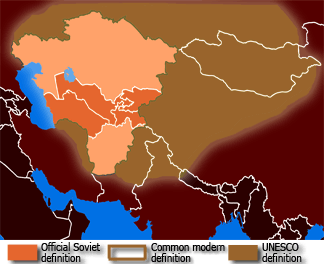Central Asia is a core region of the Asian continent from the Caspian Sea in the west, China in the east, Afghanistan in the south, and Russia in the north. It is also sometimes referred to as Middle Asia, and, colloquially, “the -stans” (as the five countries generally considered to be within the region all have names ending with that suffix) and is within the scope of the wider Eurasian continent.
Various definitions of its exact composition exist, and no one definition is universally accepted. Despite this uncertainty in defining borders, it does have some important overall characteristics. For one, Central Asia has historically been closely tied to its nomadic peoples and the Silk Road. As a result, it has acted as a crossroads for the movement of people, goods, and ideas between Europe, West Asia, South Asia, and East Asia.
In modern contexts, all definitions of Central Asia consensually include these five republics of the former Soviet Union: Kazakhstan (pop. 16.0 million), Kyrgyzstan (5.5 million), Tajikistan (7.3 million), Turkmenistan (5.1 million) and Uzbekistan (27.6 million), for a total population of 61.5 million as of 2009. Other areas often included are Mongolia, Afghanistan, northern and western Pakistan, northeastern Iran, Kashmir, and sometimes Xinjiang in western China and southern Siberia in Russia.
During pre-Islamic and early Islamic times, Central Asia was a predominantly Iranian region that included sedentary Sogdians, Chorasmians and semi-nomadic Scythians, Alans. The ancient sedentary population played an important role in the history of Central Asia. After expansion by Turkic peoples, Central Asia became more and more the homeland for many Turkic peoples, including the Uzbeks, Kazakhs, Kyrgyz, and Uyghurs, and Central Asia is sometimes referred to as Turkestan.

